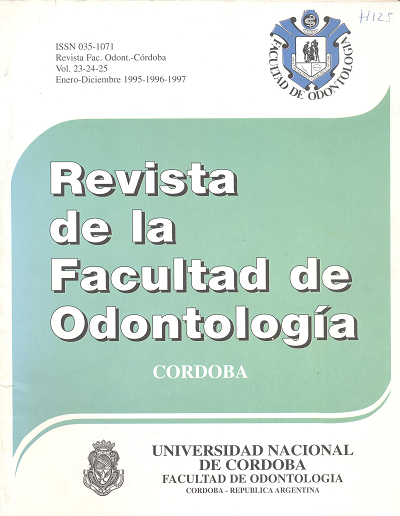Patrones morfológicos de las arcadas dentarias primarias
Keywords:
Dental Arch, Dentition, Dental OcclusionAbstract
The deciduous normal arch is studied in fifty children aged bet:ween three and five, clinically healthy, without dental illnesses, and with balanced skeletal maxillaries to obtime descriptive pattems of primary occlusions. The reference used in our pmctice belongs to foreing people, that is why we consider the chamcteristics of our fenotipe.
Results show that the upper maxillacy is transversally wider than the lower one, presenting a perimetric oveiject quite constant in canine teeth, first and second molars. The horizontal (92%) and vertical (86%) junction at anterior leve] is important, with an overbite of the third gingival or severe overbite (40%). Interdental separations of dental arches are presented as generalized, both in the upper maxillacy (46%) and in the lower maxillacy (41%). The temporary dental elements show a generally bigger size compared to the ones optimed in other foreign societies. The cartine and molar relationship indicates a 96% of canine Class I and 84 of straight terminal plane. The temporacy arch rate is described when relating the maximum with and length
Downloads
Published
Issue
Section
License
Aquellos autores/as que tengan publicaciones con esta revista, aceptan los términos siguientes:
- Los autores/as conservarán sus derechos de autor y garantizarán a la revista el derecho de primera publicación de su obra, el cuál estará simultáneamente sujeto a la Licencia de reconocimiento de Creative Commons que permite a terceros:
- Compartir — copiar y redistribuir el material en cualquier medio o formato
- La licenciante no puede revocar estas libertades en tanto usted siga los términos de la licencia
- Los autores/as podrán adoptar otros acuerdos de licencia no exclusiva de distribución de la versión de la obra publicada (p. ej.: depositarla en un archivo telemático institucional o publicarla en un volumen monográfico) siempre que se indique la publicación inicial en esta revista.
- Se permite y recomienda a los autores/as difundir su obra a través de Internet (p. ej.: en archivos telemáticos institucionales o en su página web) después del su publicación en la revista, lo cual puede producir intercambios interesantes y aumentar las citas de la obra publicada. (Véase El efecto del acceso abierto).

